The little guide to making a great stop ball
Often sprinkle the stop? Why not - if you do it right.
by Marco Kühn
last edit:
Oct 05, 2020, 03:54 pm

He is experiencing a revolution in Roland Garros. Hugo Gaston hardly had a chance against Dominic Thiem in the ongoing rally. But the Frenchman showed brains and courage. He managed to catch up a 2-0 set deficit through partially perfectly interspersed stops. As fate would have it, it was precisely these stops that all failed at the end of the fifth sentence.
In this article, we'll check when a stopball makes sense, how best to play it, and where to ideally orientate yourself after a dropshot.
We start with the mind.
How the stop ball destroys the opponent's rhythm
You know the good feeling in the basic strokes when you play long balls with your buddy for almost ten minutes in rhythm. You feel the ball on the stringing, you are almost always right to the ball and your error rate is surprisingly low. You could also say that you are then absolutely in the flow. However, this established rhythm can easily be destroyed within ten minutes. A stop ball pulls you out of your comfort zone at the baseline. You are forced to play a ball that has nothing in common with your actual stroke. In addition, the constant sprints forwards take away stamina and therefore concentration in the long run.
These factors ensure that the previously obtained beat rhythm can no longer be found.
Dominic Thiem completed a two-hour sprint training session against Hugo Gaston. Most club players would probably only endure such training for barely twenty minutes and then smash the racket on the net post in anger.
When should you play a stop?
You should never sprinkle a stop without your head. Even if in the match between Gaston and Thiem it sometimes seemed as if the Frenchman was playing random dropshots. With his own serve Gaston put in the stop after the Thiem return. Dominic was incredibly far behind the baseline on the return. Since Gaston is left-handed, his serve with Slice to the outside - on the advantage side - had a profitable effect. Thiem was driven so far out of the field that a clever stop was an effective strategy. We'll clarify in a moment why it became so difficult for Thiem, even though he is so nimble on his feet.
So your opponent should be well behind the baseline if you want to use a targeted stop. To do this, your own position should be as close as possible or on the baseline. In the best case scenario, you are in the field. It's not that easy to play a soulful stop when you're far behind the baseline. In addition, your opponent would have more time to run for the ball.
Now let's see why Dominic had big problems with the strong stops and what you can learn from the witty Gaston.
How do you play an effective stop?
Of course, you don't just push your stop over the edge of the net somehow. You give your stops a "secret" along the way. That secret involves cutting. You tell the ball to turn either sideways or backwards when it bounces in the opposing field. Little "bastard" Gaston even played most of his stops by turning them sideways and backwards. This meant that Thiem had to play the ball so close to the net that he could only somehow push the ball over.
We will analyze in a moment what opportunities this resulted for Gaston in the rally.
We'll first of all note for you: If you want to play an incredibly effective stop in the near future, then make a note of:
1) Give the ball a "secret" (cut)
2) Observe whether your opponent is well behind the baseline
3) Make sure that you are standing as close to the baseline as possible
Where should you then orientate yourself?
You are not a tree. For this reason, you orientate yourself two to three steps into the field after your stop ball. You follow the direction of your stop. Your position then seals off almost all of your opponent's options. In the event of a possible counterstop, you are quickly ahead. If your opponent only pushes the ball over somehow, you can complete the point with a passing ball or praise.
The strategy is simple in theory: Your opponent is forced to play the ball into the back of the corner. When you play a stop as nifty as Gaston, that's damn difficult. Especially if you follow this strategy consistently.
If you come to a standstill after your terrific stop, then it is enough for your opponent to play an average counterstop. Gaston did a fantastic job against Thiem. He scored most of his stop points in the stroke after his stop ball. This was either praise or a passing ball that wasn't too risky.
Conclusion
Any tactic that leads to success is a good tactic. Sure, with 58 dropshots per match, you won't be able to welcome new friends to your Facebook friend list. But a cleverly interspersed stopball is an excellent means of breaking the opponent's rhythm and adding an effective variant to your own game.
